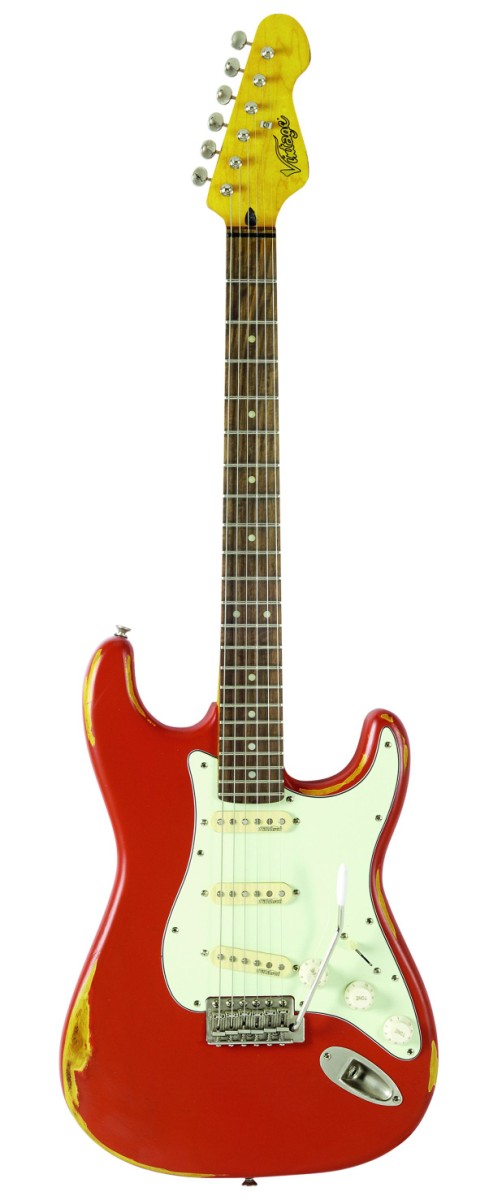MusicRadar Verdict
A proper instrument and, irrespective of your stance on the whole ageing concept, the price of £299 compares favourably with some other aged guitars.
Pros
- +
The cool Strat-like sounds. Attention to detail all round.
Cons
- -
The somewhat haphazard placement of wear.
MusicRadar's got your back
What's your stance on the ageing or relic processes offered by the likes of Fender, Gibson and Washburn?
Chances are that you'll either hate or love the idea, with the latter view enhanced if you'd had the fortune to see such a guitar up close.
Fender's Time Machine process is exhaustive to say the least, resulting in a degree of artificial yet entirely convincing wear and tear. Holding a 1959 Relic Esquire, you can almost feel the near half-century of history.
The opposing view is simple: why? What's the point of spending a significant wodge of folding stuff to buy a beat up guitar when you could revel in any one of the more affordable standard guitars?
A fair point too. So, all things considered, how would you feel about a guitar that's been artificially aged, yet has no significant history - certainly when compared against the likes of Fender and Gibson - to speak of?
Welcome a new member of the Icon series, an artificially aged version of a guitar already nestling in the arms of the Vintage range.
Overview
Thanks to Fender's ceaseless toil to protect its trademarks, it's the headstock of this otherwise instantly recognisable double-cut that gives it away. In fact, only the front of the paddle has a gloss finish; the remainder of the guitar is wholly matt.
Although the finish of this example is described as 'Firenza' red, we don't think it sails quite as close to the wind as the other option, Woodstock white.
And although the ageing of the poplar body is a tad zealous in its placement, getting down to the bare wood is a vital part of the process that has been respected here.
The mint-green hue of an old three-ply white/black/white pickguard has been recreated too, and fixtures such as the vibrato and blade tips and knobs (which wouldn't turn green over time, of course) are discoloured in just the right way, with the chrome Wilkinson parts benefiting from a restrained session with the steel wool.
There's no faux rust here clogging up the saddles, which we prefer, and even though the overly thick rosewood 'board compromises whatever authenticity Vintage may have aimed for, the guitar plays very nicely indeed.
We can even forgive the rather nasty turmeric yellow hue that's been applied to the majority of bare wood…
Sounds
Courtesy of a trio of WVS single-coils we can again report that the gamut of associated tones is present, all the way from SRV's neck pickup aggression to Knopfler's glassy twang and beyond.
The level of sheer treble on offer should you need it is most inspiring, and if you intend to use this through a super-loud amp, you may need to have an ambulance standing by.
Great fun though. It's also worth mentioning that the pivot vibrato operates in a satisfyingly valid manner too and we really couldn't find much to grumble about tone-wise, all things considered.
Simon Bradley is a guitar and especially rock guitar expert who worked for Guitarist magazine and has in the past contributed to world-leading music and guitar titles like MusicRadar (obviously), Guitarist, Guitar World and Louder. What he doesn't know about Brian May's playing and, especially, the Red Special, isn't worth knowing.
“Every one of them said yes without hesitation": Hank Marvin and Roger Taylor have just remade a '60s classic for charity
Do you know where your money goes when you buy a gig ticket? A new report breaks it down
“Every note counts and fits perfectly”: Kirk Hammett names his best Metallica solo – and no, it’s not One or Master Of Puppets










